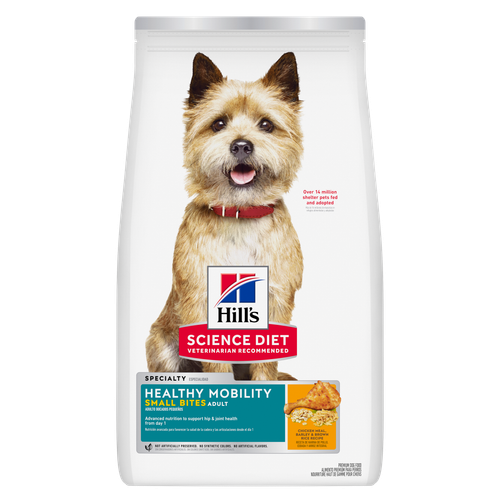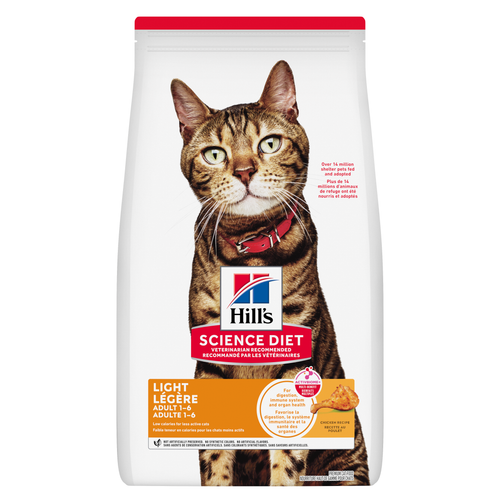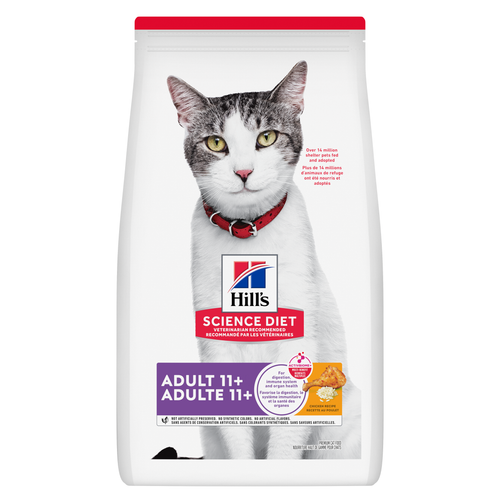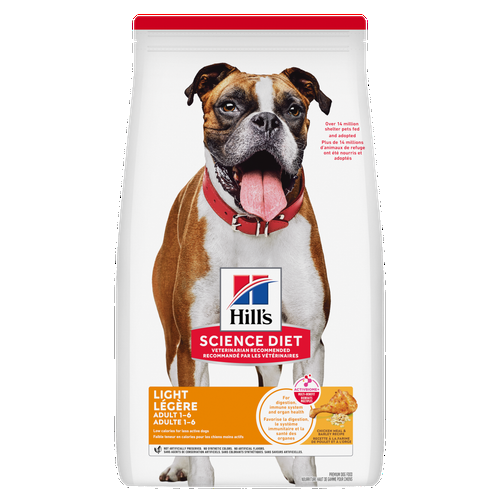
-
Find the right food for your petTake this quiz to see which food may be the best for your furry friend.Find the right food for your petTake this quiz to see which food may be the best for your furry friend.Featured products
 Adult Healthy Mobility Small Bites Chicken Meal, Barley & Brown Rice Recipe Dog Food
Adult Healthy Mobility Small Bites Chicken Meal, Barley & Brown Rice Recipe Dog FoodAdvanced nutrition to support hip & joint health from day 1
Shop Now Adult Sensitive Stomach & Skin Small & Mini Chicken Recipe Dog Food
Adult Sensitive Stomach & Skin Small & Mini Chicken Recipe Dog FoodHill's Science Diet Sensitive Stomach & Skin Small & Mini dry dog food is tailored nutrition for Small & Mini dogs while being gentle on stomachs. Nourishes skin & promotes a lustrous coat.
Shop Now Adult Light Large Breed Chicken Meal & Barley Recipe Dog Food
Adult Light Large Breed Chicken Meal & Barley Recipe Dog Food18% lower calories vs. Science Diet Large Breed Adult
Shop NowFeatured products Adult Light Chicken Recipe Cat Food
Adult Light Chicken Recipe Cat Food20% lower calories vs. Hill's Science Diet Adult
Shop Now Adult Healthy Cuisine Seared Tuna & Carrot Medley Cat Food
Adult Healthy Cuisine Seared Tuna & Carrot Medley Cat FoodDelicious seared tuna paired with tender carrots in a mouthwatering sauce
Shop Now Adult 11+ Chicken Recipe Cat Food
Adult 11+ Chicken Recipe Cat FoodSupports brain health & beautiful fur. Helps keep immune system, heart & kidneys healthy.
Shop Now -
Dog
- Dog Tips & Articles
-
Health Category
- Weight
- Food & Environmental Sensitivities
- Urinary
- Digestive
- Joint
- Kidney
- Dental
- Cancer
-
Life Stage
- Puppy Nutrition
- Adult Nutrition
- Senior Nutrition
Cat- Cat Tips & Articles
-
Health Category
- Weight
- Skin & Food Sensitivities
- Urinary
- Digestive
- Kidney
- Dental
- Stress
- Cancer
-
Life Stage
- Kitten Nutrition
- Adult Nutrition
Featured articles Antioxidants
AntioxidantsUnderstand the importance of antioxidants in your dog or cat's food, and how they can help protect your pet and keep them healthy.
Read More Water
WaterDiscover why water is the most important nutrient for your dog or cat to live a healthy life. Find out how much water your pet should consume each day.
Read More Importance of DHA in your Pet's Food
Importance of DHA in your Pet's FoodLearn about DHA, Docosahexaenoic Acid, a natural omega-3 fatty acid that is essential in the development of the brain and nervous system in cats & dogs.
Read More -


Can dogs get splinters? Even though their paw pads are pretty tough, they can still be penetrated by thorns and splinters of wood, glass, metal or any other hard, sharp material. Dogs may be so focused on sniffing, playing or chasing a ball that they might not see sharp hazards that can end up as a splinter in a dog's paw.
Paws aren't the only body part that are at risk for splinters. Dogs don't tend to discriminate when they are chewing on something fun or delicious (they are missing that whole prefrontal cortex logic part of the brain), so they can sometimes end up with bone splinters stuck in their mouths.
Here's a look at how you can figure out if your furry friend has a splinter and what you can do to help them.
Signs Your Dog Has a Splinter
Now that you indeed know that dogs can get splinters, it's important to know the signs. If your dog suddenly starts limping, don't panic! It could be a simple splinter, thorn or insect sting. If you notice your dog is excessively licking or chewing at a paw or other body part, it could also be a splinter. If your dog is pawing at their mouth, drooling, refusing to eat, chewing only on one side or suddenly head shy, there could be a splinter in their mouth.

What to Do if You Notice a Splinter in a Dog's Paw
If you can see the end of the splinter poking through the skin, there is a good possibility that you can remove it yourself quickly and easily, provided your dog will let you. Remember — safety first! Even the nicest dog can bite if they're in pain. If you attempt this, make sure you don't push the splinter farther in. Don't be afraid to trim the hair around the splinter to make it more visible. Using tweezers (the ones from first-aid kits are the best for this kind of work), firmly grasp the end of the splinter. You want to pull it out slowly and smoothly to avoid breaking off any part of the splinter under the skin. Make sure to pull in the direction of the splinter and not up and out, as this has a tendency to break the splinter. After you remove the splinter, use a cotton ball or swab to apply some dog-safe antiseptic to the wound; talk to your veterinarian to get their recommendation for the safest antispeptics for your dog.
If the splinter is completely embedded under the skin or not visible to you, do not try to extract it. Doing so may cause stress and injury to you and your pet. You can try soaking your dog's paw in a bowl filled with a warm Epsom salt solution for five to ten minutes. Doing so may soften the area and bring the splinter close enough to the surface of the skin so that you can see it and grab it. You might also want to enlist the help of a friend or family member to help hold your dog to keep them relaxed and free you up to concentrate on getting the splinter out. Again — safety first!


Tasty Tips
When to See a Veterinarian
While a splinter is usually nothing to worry about, there are some situations where it's best to let your vet take care of a splinter. A vet needs to get involved if your dog:
- has a splinter in their mouth.
- has a splinter (anywhere) that doesn't come out in 24 hours.
- becomes agitated when you try to remove the splinter.
- is limping or licking the affected area.
- has an infection that appears to be forming.
Don't panic! Enlist the help of your friendly neighborhood vet who can extract the splinter, keep everybody safe and manage pain and stress.
Dogs can get splinters just like humans, but knowing how to spot the signs of a splinter and take care of it promptly can help keep your pup happy, healthy and splinter-free.


Dr. Sarah Wooten graduated from UC Davis School of Veterinary Medicine in 2002. A member of the American Society of Veterinary Journalists, Dr. Wooten divides her professional time between small animal practice in Greeley, Colorado, public speaking on associate issues, leadership, and client communication, and writing. She enjoys camping with her family, skiing, SCUBA, and participating in triathlons.
Related products

18% lower calories vs. Science Diet Large Breed Adult

Advanced nutrition to support hip & joint health from day 1

18% lower calories vs. Science Diet Adult

Hill's Science Diet Sensitive Stomach & Skin Small & Mini dry dog food is tailored nutrition for Small & Mini dogs while being gentle on stomachs. Nourishes skin & promotes a lustrous coat.
Related articles

Discover how the field of dog science is giving us more and more insights into the inner workings of our furry best friends.

Your dog's coat and skin are a big part of your dog's overall health. Ensure you keep your dog's coat healthy, by following these simple tips.

Learn basic steps & precautions for treating a cut on your dog, including what you can put on the cut, and when you should take them to the vet.

Learn how dogs with sensitive skin can have special dietary needs, how they can develop over time in a healthy dog, and how Hill's dog food can help.

Put your dog on a diet without them knowing
Our low calorie formula helps you control your dog's weight. It's packed with high-quality protein for building lean muscles, and made with purposeful ingredients for a flavorful, nutritious meal. Clinically proven antioxidants, Vitamin C+E, help promote a healthy immune system.
Put your dog on a diet without them knowing
Our low calorie formula helps you control your dog's weight. It's packed with high-quality protein for building lean muscles, and made with purposeful ingredients for a flavorful, nutritious meal. Clinically proven antioxidants, Vitamin C+E, help promote a healthy immune system.

